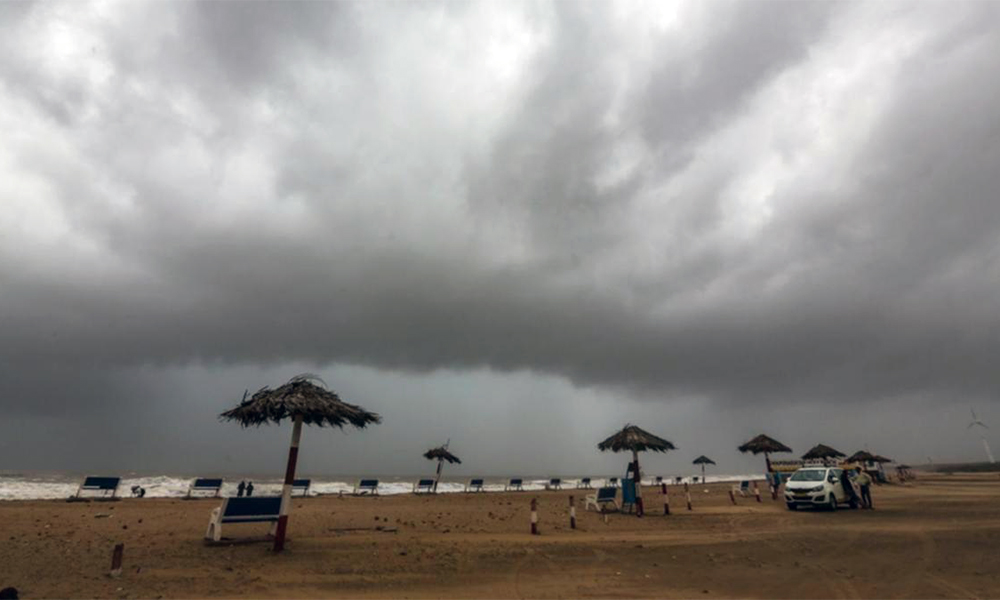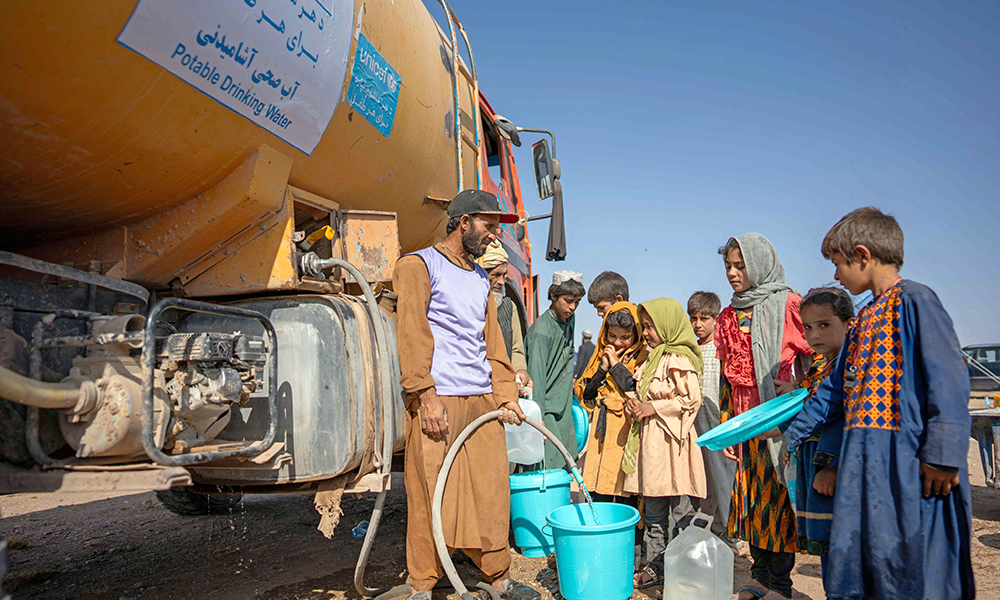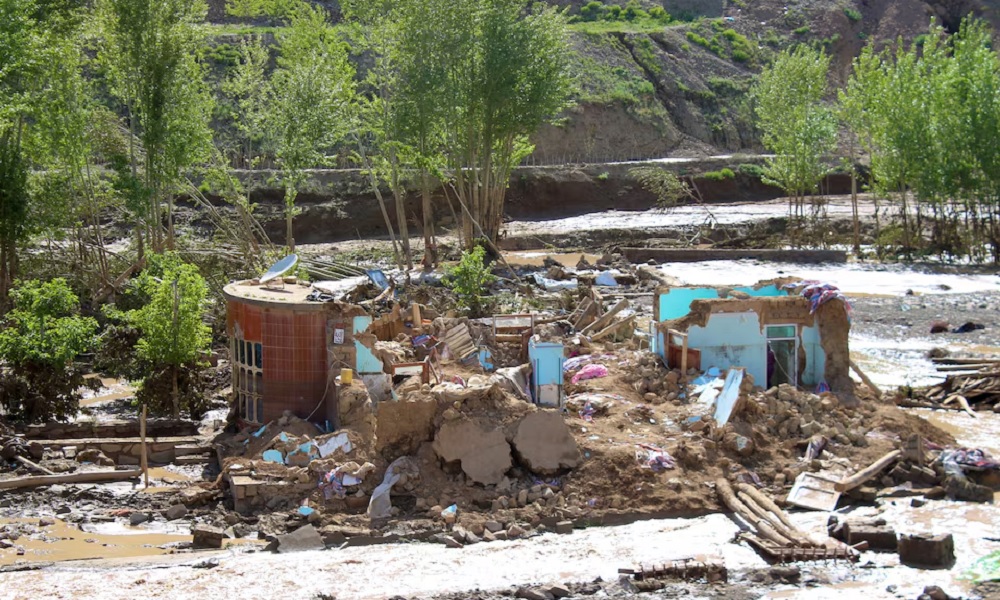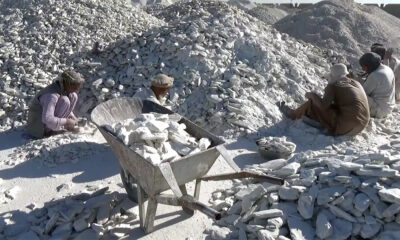Climate Change
India, Pakistan brace for fast approaching cyclone

Authorities in India’s western state of Gujarat evacuated more than 75,000 people from vulnerable coastal communities with cyclone Biparjoy expected to whirl in from the Arabian Sea and make landfall by Thursday evening.
Early on Thursday, the storm, classified as a very severe cyclone, was centered 180 km off Jakhau port in Gujarat and 270 km off Karachi in Pakistan, the India Meteorological Department (IMD) said.
The storm appeared to have lost some of its intensity, and is expected to have a maximum sustained wind speed of 115-125 kmph gusting up to 140 kmph, down from the 150 kmph that the IMD had estimated on Wednesday.
There was no change in its path, however, and the cyclone was still expected to make landfall near India’s Jakhau port, between Mandvi in Gujarat and Karachi, the IMD said.
In the coastal town of Mandvi, a Reuters witness said while winds were high, the sky was blue and the sun was out on Thursday morning with shops starting to open and people coming out on the streets.
“On Thursday morning, wind speed as high as 90 kmph were reported on Gujarat coast,” said a senior IMD official.
“The speed will rise gradually in the next few hours to 120 kmph, gusting to 135 kmph in the afternoon. We are expecting landfall in the evening when wind speeds would be even higher.”
Auditorium halls in schools and other government buildings were converted into relief camps to provide shelter to displaced people in both India and Pakistan.
Ships and boats have been moved from some areas of Pakistan’s coast while hospitals in the region were put on high alert as part of preparations for the cyclone.
Pakistan Climate Change Minister Sherry Rehman said Karachi, a port city of 20 million people, was not under immediate threat, but emergency measures were being taken to deal with winds and rain that were expected to batter the economic hub.
“There will be voluntary evacuations carrying on in the city of Karachi, which is, sort of, not directly in the eye of the storm like the coastal areas … but it is certainly going to feel the brunt of high intensity, high velocity winds, as well as rainfall,” Rehman said, as residents in Karachi stocked up on essential food and grains.
Temporary thatched houses in coastal Gujarat could be completely flattened while standing crops, plantations and roads were expected to face major damage, the IMD said in a statement, adding that railways could also face disruption.
Indian authorities suspended fishing until Friday, closed down schools and banned people from using beaches.
Many offshore oil installations and major ports, which line the coasts of Gujarat, have suspended operations.
“We have evacuated more than 75,000 persons from the eight coastal districts in Gujarat that are expected to be impacted by the cyclone,” said Kamal Dayani, a senior official overseeing rescue operations.
IEA’s central bank director meets with Chinese ambassador
Hedayatullah Badri, Director General of Da Afghanistan Bank (central bank), met on Thursday with Wang Yu, ambassador of China in Kabul.
According to a statement issued by the bank, numerous issues were discussed including matters around banking transactions, trading, and trade.
“During this meeting, the importance of bilateral economic cooperation was mentioned and the economic cooperation between both countries was emphasized,” the statement read.
“Da Afghanistan Bank, as the central bank of the country, is committed to have better banking relations with all countries of the world, especially financial and banking institutions, and to develop these relations in the light of international laws and regulations,” the bank said.
Climate Change
UN and ICRC warn of serious water shortage in Afghanistan
The International Committee of the Red Cross in Afghanistan reported that an estimated 33 million people in the country face severe water shortage

The United Nations Human Settlements Programme (UN Habitat) warned this week that 21 million people in Afghanistan are currently facing a serious water crisis and that the country needs major investments in water infrastructure.
Stephanie Loose, the head of the programme, said in a report that major Afghan cities such as Kabul, Kandahar and Herat are also facing a serious shortage of clean drinking water and that groundwater resources in these cities are decreasing significantly.
However, last week, the International Committee of the Red Cross (ICRC) in Afghanistan reported that an estimated 33 million people in the country face severe water shortage.
Marking World Water Day on March 22, the ICRC quoted a Kabul resident Shafiqullah Hamkar of District 5 in Kabul city as saying: “Our borewells have completely dried up because of the minimal snowfall and rainfall over the last few years.
“The sharp decline in groundwater levels has left us no choice but to rely on commercial water tankers for our most basic needs. It is a big challenge for us in the city,” he said.
ICRC said Hamkar represents an estimated 80% of Afghans who are dealing with the severe impact of erratic rainfall patterns, rising temperatures and droughts.
The situation is even worse in rural areas where people often rely on untreated surface water, which leads to the spread of waterborne diseases such as cholera and diarrhea.
“For millions of Afghans, who are already struggling with many challenges and facing a dire humanitarian situation, vital activities such as getting water to drink or cook and providing irrigation for crops are often impossible. This has a devastating impact on people’s health and access to food, and hampers the country’s potential for economic development,” says Martin De Boer, the head of programs for the International Committee of the Red Cross (ICRC) in Afghanistan.
He added that the lack of required infrastructure – including water-supply systems, dams and irrigation networks – further exacerbates the challenges. Responding to the needs of the people, the ICRC plays an important role in supporting communities and assisting authorities to improve and manage water supplies.
Climate Change
Over 500,000 Afghans displaced due to climate disasters in 2024: IOM

More than half a million people in Afghanistan were displaced due to climate disasters in 2024, the International Organization for Migration said in a country report published on Tuesday.
“Nearly 9 million individuals were impacted by climate hazards in the last 12 months, with over 500,000 displaced by floods, drought, and other disasters,” IOM said, AFP reported.
“Roughly three in five of those displaced relocated elsewhere within their province of origin”, with the western Herat and Farah provinces among the hardest hit, it said.
This week, 39 people were killed due to floods, hail and storms in southwestern Afghanistan, mainly in Farah, according to local authorities.
Afghanistan is among the poorest countries in the world after decades of war and is ranked the sixth most vulnerable to climate change, which is spurring extreme weather.
Drought, floods, land degradation and declining agricultural productivity are key threats, according to the United Nations.
Flash floods last May killed hundreds and swamped swaths of agricultural land in Afghanistan, where 80 percent of people depend on farming to survive.
“Over 11 million people in Afghanistan are at high risk of severe impacts from climate-induced disasters in the future,” the IOM said.
The UN agency estimates that “climate-sensitive livelihoods, like subsistence farming, make up 73 percent of jobs in Afghanistan”.
It added that “92 percent of villages have limited access to emergency services” and “96 percent lack resources for crucial measures like early warning systems and search and rescue.”
Climate Change
Floods in Farah and Kandahar claim the lives of 29 people

Officials from the disaster management departments of Farah and Kandahar report that floods in these two provinces have resulted in 29 fatalities and nine injuries.
Mohammad Israel Sayar, the head of disaster management in Farah, confirmed to Ariana News that 21 people lost their lives and six others were injured due to floods on Tuesday in the Qala-e-Kah district of the province.
According to Sayar, the victims had gone to the mountains of Qala-e-Kah for recreation purposes when floodwaters suddenly swept them away.
Officials from the disaster management department in Kandahar also stated that floods in the province have caused 11 deaths and injuries.
They reported that in the seventh district of the province, one woman and three children died when the roof of a house collapsed.
They added that in the fifth security district of the province, three women and one child lost their lives due to the floods. Two children and one man were also injured.
-

 Business5 days ago
Business5 days agoAfghanistan ships first consignment to Europe via Khaf-Herat railway
-

 Business4 days ago
Business4 days ago36 mining contracts inked over the past year: Mines ministry
-

 Latest News4 days ago
Latest News4 days agoDried fruit market in Herat booms ahead of Eid-al-Fitr
-

 Regional4 days ago
Regional4 days agoPowerful quake in Southeast Asia kills several, Myanmar declares state of emergency
-

 Latest News4 days ago
Latest News4 days agoUS may ask for military equipment left behind in Afghanistan: Trump
-

 International Sports4 days ago
International Sports4 days agoLucknow’s six-hitting machine Pooran justifies top order slot
-

 Latest News3 days ago
Latest News3 days agoMore than 70,000 Afghans returned home in third week of March: IOM
-

 Latest News4 days ago
Latest News4 days agoNegotiations with Afghanistan are the only way forward: Pakistan’s ex-PM Khan

























